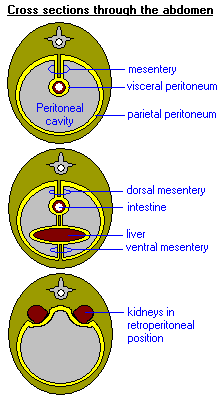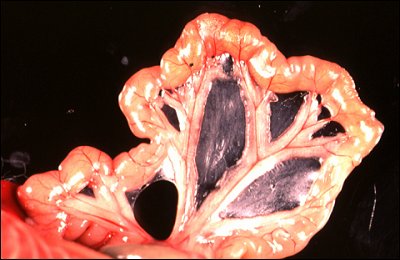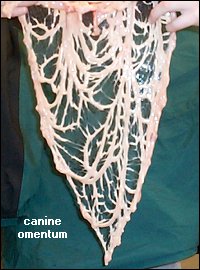VIVO Pathophysiology
Peritoneum, Mesentery, and Omentum

The peritoneum is thin membrane that lines the abdominal and pelvic cavities, and covers most abdominal viscera. It is composed of layer of mesothelium supported by a thin layer of connective tissue.
Although ultimately one continuous sheet, two types of peritoneum are referenced:
- Parietal peritoneum is that portion that lines the abdominal and pelvic cavities. Those cavities are also known as the peritoneal cavity.
- Visceral peritoneum covers the external surfaces of most abdominal organs, including the intestinal tract.
As seen in the diagram to the right, the intestines are, in essence, suspended from the dorsal aspect of the peritoneal cavity by a fused, double layer of parietal peritoneum called mesentery. In come cases, parietal and visceral peritoneum are also continuous along the ventral abdomen, where they are called ventral mesentery.
Some organs protrude into the abdominal cavity, but are not encased in visceral peritoneum. The kidneys lie in this type of position and are said to be in a retroperitoneal location.
The term mesentery tends to be used as a generic term describing peritoneal extensions not only from the intestine (as -entery implies), but from all abdominal and pelvic organs. To be more precise, and less offensive to language purists, sections of peritoneum that suspend specific organs are individually named; for example, mesogastrium for the stomach, mesojejunum for the jejunum and mesometrium for the uterus.
An important feature of mesentery is that it serves as a conduit for blood vessels, nerves and lymphatic vessels going to and from the organ in question. The image below shows a loop of small intestine from a mouse. The glistening membrane inside the loop of bowel is mesentery; mesenteric blood vessels running through bundles of fat are clearly visible.

Omenta are abdominal structures formed from peritoneum and structurally similar to mesentery. The visceral peritoneum covering the stomach extends on both sides into large, double-layered sheets that are filled with prominent patches of fat, giving it a lace-like appearance. The lesser omentum arises from the lesser curvature of the stomach and extends to the liver. The greater omentum is given off from the greater curvature of the stomach, forms a large sheet that lies over the intestines, then converges into parietal peritoneum.

Send comments to Richard.Bowen@colostate.edu
